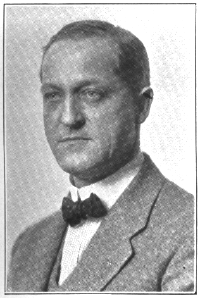John Paulding (sculptor)
John Paulding | |
|---|---|
 | |
| Born | April 5, 1883 |
| Died | April 15, 1935[1] |
| Nationality | American |
| Education | The Art Institute of Chicago |
| Known for | Sculptor |

John Paulding (April 5, 1883 – April 15, 1935) was an American sculptor best remembered for his World War I memorials. Paulding was born in Darke County, Ohio. He studied sculpture at the Art Institute of Chicago and was to remain in Chicago until his death at an early age in 1935.[4]
At least two of his World War I memorials became very popular and casts of them can be found in many places throughout the United States.
Controversy with E. M. Viquesney[edit]
Paulding and sculptor E. M. Viquesney both produced very similar World War I monuments within a few months of each other, resulting in various copyright violation lawsuits.[3]
Works[edit]
- American Doughboy, 1920.
- Ardmore, Oklahoma, at Walter W. Drew's gravesite in Rosehill Cemetery.[5]
- Bay City, Michigan
- Northampton, Pennsylvania
- Olathe, Kansas
- Paducah, Kentucky
- Pueblo, Colorado
- Racine, Wisconsin
- Saline, Michigan
- Van Buren, Missouri[6]
- Second-Lieutenant Francis Lowry Memorial, Fairmount Cemetery, Denver, Colorado, 1921. The fallen aviator after whom Lowry Air Force Base was named.
- Major-General James B. McPherson (The Reconnoissance), Memorial Park, McPherson County Courthouse, McPherson, Kansas, 1917.
- Over the Top, 1921.
- Albany, Missouri[7]
- Amarillo, Texas
- Astoria, Oregon
- Bolton Landing, New York
- Buffalo, New York[8]
- Catskill, New York
- Chicago, Illinois[9]
- Chillicothe, Ohio
- Cincinnati, Ohio
- Elgin, Illinois[10]
- Evanston, Wyoming[11]
- Freeburg, Illinois
- Jonesboro, Arkansas[12]
- Knoxville, Tennessee[13]
- Ladysmith, Wisconsin[14]
- Leavenworth, Kansas[15]
- Llano, Texas
- Manitou Springs, Colorado
- Marshall, Missouri
- Martins Ferry, Ohio
- McMinnville, Oregon
- Missoula, Montana[16]
- Newberry, South Carolina
- Norfolk, Nebraska[17]
- Onaga, Kansas[18]
- Pittsburgh, Pennsylvania
- Salem, Oregon (Over the Top to Victory)[19]
- South Haven, Michigan
- Valentine, Nebraska
- Wahpeton, North Dakota
- Wautoma, Wisconsin
- Wheaton, Illinois[20]
- Williamsport, Maryland
- Winner, South Dakota
-
Major-General McPherson (1917), McPherson County Courthouse, McPherson, Kansas.
-
Lowry Memorial (1921), Fairmount Cemetery, Denver, Colorado.
-
Over the Top (1921), Llano, Texas.
See also[edit]
- Astoria Victory Monument, Astoria, Oregon
References[edit]
Wikimedia Commons has media related to John Paulding (sculptor).
- ^ "Illinois, Cook County Deaths, 1878–1994". FamilySearch. The Church of Jesus Christ of Latter-day Saints. May 17, 2016. Retrieved December 21, 2016.
- ^ "World War I Memorial, (sculpture)". Smithsonian Institution Research Information System. Smithsonian Institution. Retrieved December 21, 2016.
- ^ a b Kopel, Les; Goldsmith, Earl. "The Doughboy "War": E.M. Viquesney vs. John Paulding". The E.M.Viquesney Doughboy Database. Retrieved September 1, 2013.
- ^ Opitz, Glenn B, editor, Mantle Fielding's Dictionary of American Painters, Sculptors & Engravers, Apollo Book, Poughkeepsie NY, 1986 p 703
- ^ "This and That Newsletter". OklahomaHistory.net. Butch and Jill Bridges. Retrieved December 21, 2016.
The WalterDrew2.jpg picture confirms the work was done by Paulding.
- ^ "Soldiers Monument, (sculpture)". Smithsonian Institution Research Information System. Smithsonian Institution. Retrieved December 21, 2016.
- ^ "Over the Top, (sculpture)". Smithsonian Institution Research Information System. Smithsonian Institution. Retrieved December 21, 2016.
- ^ "Over the Top to Victory, (sculpture)". Smithsonian Institution Research Information System. Smithsonian Institution. Retrieved December 21, 2016.
- ^ Paulding, John. "Over the Top". Siris-artinventories.si.edu. Retrieved December 7, 2017.
- ^ Paulding, John (December 7, 2017). "World War I Soldier". Siris-artinventories.si.edu. Retrieved December 7, 2017.
- ^ "Uinta County War Memorial". Smithsonian Collections Search Center. Smithsonian Institution. Retrieved December 15, 2016.
- ^ "World War I Markers and Memorials". The Encyclopedia of Arkansas History & Culture. The Central Arkansas Library System. Retrieved December 21, 2016.
- ^ Paulding, John (December 7, 2017). "Doughboy". Siris-artinventories.si.edu. Retrieved December 7, 2017.
- ^ Paulding, John (December 7, 2017). "Over the Top". Siris-artinventories.si.edu. Retrieved December 7, 2017.
- ^ "Doughboy (sculpture)". Smithsonian Institution Research Information System. Smithsonian Institution. Retrieved December 21, 2016.
- ^ Paulding, John (December 7, 2017). "Over the Top to Victory". Siris-artinventories.si.edu. Retrieved December 7, 2017.
- ^ "Veteran Memorial, (sculpture)". Smithsonian Institution Research Information System. Smithsonian Institution. Retrieved December 21, 2016.
- ^ "The Charging Doughboy, (sculpture)". Smithsonian Institution Research Information System. Smithsonian Institution. Retrieved December 21, 2016.
- ^ Paulding, John (December 7, 2017). "Over the Top to Victory". Siris-artinventories.si.edu. Retrieved December 7, 2017.
- ^ ""Over the Top to Victory" Doughboy Statue - Wheaton, IL - World War I Memorials and Monuments on Waymarking.com". Waymarking.com. Retrieved December 7, 2017.



